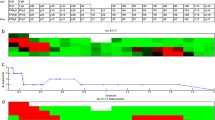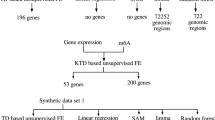Abstract
Spatiotemporal gene expression data of the human brain offer insights on the spatial and temporal patterns of gene regulation during brain development. Most existing methods for analyzing these data consider spatial and temporal profiles separately, with the implicit assumption that different brain regions develop in similar trajectories, and that the spatial patterns of gene expression remain similar at different time points. Although these analyses may help delineate gene regulation either spatially or temporally, they are not able to characterize heterogeneity in temporal dynamics across different brain regions, or the evolution of spatial patterns of gene regulation over time. In this article, we develop a statistical method based on low-rank tensor decomposition to more effectively analyze spatiotemporal gene expression data. We generalize the classical principal component analysis (PCA), which is applicable only to data matrices, to tensor PCA that can simultaneously capture spatial and temporal effects. We also propose an efficient algorithm that combines tensor unfolding and power iteration to estimate the tensor principal components efficiently, and provide guarantees on their statistical performance. Numerical experiments are presented to further demonstrate the merits of the proposed method. An application our method to a spatiotemporal brain expression data provides insights on gene regulation patterns in the brain.





Similar content being viewed by others
References
Alter O, Brown P, Botstein D (2000) Singular value decomposition for genome-wide expression data processing and modeling. Proc Natl Acad Sci 97:10101–10106
Coyle JT, Price DL, Delong MR (1983) Alzheimer’s disease: a disorder of cortical cholinergic innervation. Science 219 (4589):1184–1190
De Lathauwer L, De Moor B, Vandewalle J (2000) A multilinear singular value decomposition. SIAM J Matrix Anal Appl 21 (4):1253–1278
de Silva V, Lim LH (2008) Tensor rank and the ill-posedness of the best low-rank approximation problem. SIAM J Matrix Anal Appl 30 (3):1084–1127
Donoso M, Collins AG, Koechlin E (2014) Foundations of human reasoning in the prefrontal cortex. Science 344 (6191):1481–1486
Fjell AM, Westlye LT, Amlien I, Espeseth T, Reinvang I, Raz N, Agartz I, Salat DH, Greve DN, Fischl B et al (2009) High consistency of regional cortical thinning in aging across multiple samples. Cereb cortex 19:2001–2012
Gutchess AH, Kensinger EA, Schacter DL (2007) Aging, self-referencing, and medial prefrontal cortex. Soc Neurosci 2 (2):117–133
Hawrylycz M, Miller JA, Menon V, Feng D, Dolbeare T, Guillozet-Bongaarts AL, Jegga AG, Aronow BJ, Lee CK, Bernard A et al (2015) Canonical genetic signatures of the adult human brain. Nat Neurosci 18 (12):1832
Hillar C, Lim L (2013) Most tensor problems are np-hard. J ACM 60 (6):45
Jolliffe I (2002) Principal component analysis. Springer, Berlin
Kandel ER, Schwartz JH, Jessell TM et al (2000) Principles of neural science, vol 4. McGraw-Hill, New York
Kang HJ, Kawasawa YI, Cheng F, Zhu Y, Xu X, Li M, Sousa AM, Pletikos M, Meyer KA, Sedmak G et al (2011) Spatio-temporal transcriptome of the human brain. Nature 478 (7370):483–489
Kato T (1982) A short introduction to perturbation theory for linear operators. Springer, New York
Koldar TG, Bader BW (2009) Tensor decompositions and applications. SIAM Rev 51:455–500
Koltchinskii V, Lounici K (2014) Asymptotics and concentration bounds for bilinear forms of spectral projectors of sample covariance. arXiv:14084643
Landel V, Baranger K, Virard I, Loriod B, Khrestchatisky M, Rivera S, Benech P, Féron F (2014) Temporal gene profiling of the 5xfad transgenic mouse model highlights the importance of microglial activation in Alzheimer’s disease. Mol Neurodegener 9 (1):1–18
Laurent B, Massart P (1998) Adaptive estimation of a quadratic functional by model selection. Ann Stat 28 (5):1303–1338
Lauria G, Holland N, Hauer P, Cornblath DR, Griffin JW, McArthur JC (1999) Epidermal innervation: changes with aging, topographic location, and in sensory neuropathy. J Neurol Sci 164 (2):172–178
Lein ES, Hawrylycz MJ, Ao N, Ayres M, Bensinger A, Bernard A, Boe AF, Boguski MS, Brockway KS, Byrnes EJ et al (2007) Genome-wide atlas of gene expression in the adult mouse brain. Nature 445 (7124):168–176
Lidskii V (1950) The proper values of the sum and product of symmetric matrices. Dokl Akad Nauk SSSR 75:769–772
Lin Z, Sanders SJ, Li M, Sestan N, State MW, Zhao H (2015) A markov random field-based approach to characterizing human brain development using spatial-temporal transcriptome data. Ann Appl Stat 9 (1):429
Liu T, Lee KY, Zhao H (2016) Ultrahigh dimensional feature selection via kernel canonical correlation analysis. arXiv:160407354
Luebke J, Chang YM, Moore T, Rosene D (2004) Normal aging results in decreased synaptic excitation and increased synaptic inhibition of layer 2/3 pyramidal cells in the monkey prefrontal cortex. Neuroscience 125 (1):277–288
Miller JA, Ding SL, Sunkin SM, Smith KA, Ng L, Szafer A, Ebbert A, Riley ZL, Royall JJ, Aiona K et al (2014) Transcriptional landscape of the prenatal human brain. Nature 508 (7495):199–206
Montanari A, Richard E (2014) A statistical model for tensor pca. NIPS
Muirhead RJ (2009) Aspects of multivariate statistical theory, vol 197. Wiley, Hoboken
Nevalainen P, Lauronen L, Pihko E (2014) Development of human somatosensory cortical functions—what have we learned from magnetoencephalography: a review. Front Hum Neurosci 8:158
Pardo JV, Lee JT, Sheikh SA, Surerus-Johnson C, Shah H, Munch KR, Carlis JV, Lewis SM, Kuskowski MA, Dysken MW (2007) Where the brain grows old: decline in anterior cingulate and medial prefrontal function with normal aging. Neuroimage 35 (3):1231–1237
Parikshak NN, Luo R, Zhang A, Won H, Lowe JK, Chandran V, Horvath S, Geschwind DH (2013) Integrative functional genomic analyses implicate specific molecular pathways and circuits in autism. Cell 155 (5):1008–1021
Pletikos M, Sousa AM, Sedmak G, Meyer KA, Zhu Y, Cheng F, Li M, Kawasawa YI, Šestan N (2014) Temporal specification and bilaterality of human neocortical topographic gene expression. Neuron 81 (2):321–332
Raz N, Lindenberger U, Rodrigue KM, Kennedy KM, Head D, Williamson A, Dahle C, Gerstorf D, Acker JD (2005) Regional brain changes in aging healthy adults: general trends, individual differences and modifiers. Cereb Cortex 15 (11):1676–1689
Sabatinelli D, Bradley MM, Fitzsimmons JR, Lang PJ (2005) Parallel amygdala and inferotemporal activation reflect emotional intensity and fear relevance. Neuroimage 24 (4):1265–1270
Sheehan BN, Saad Y (2007) Higher order orthogonal iteration of tensors (hooi) and its relation to pca and glram. In: Proceedings of the 2007 SIAM International Conference on Data Mining, SIAM, pp 355–365
Vershynin R (2012) Introduction to the non-asymptotic analysis of random matrices. In: Compressed Sensing. Cambridge University Press, Cambridge pp 210–268
Wall M, Dyck P, Brettin T (2001) Singular value decomposition analysis of microarray data. Bioinformatics 17:566–568
Wedin P (1972) Perturbation bounds in connection with singular value decomposition. BIT Num Math 12 (1):99–111
Wen X, Fuhrman S, Michaels GS, Carr DB, Smith S, Barker JL, Somogyi R (1998) Large-scale temporal gene expression mapping of central nervous system development. Proc Natl Acad Sci 95 (1):334–339
Yeung KY, Ruzzo WL (2001) Principal component analysis for clustering gene expression data. Bioinformatics 17 (9):763–774
Zhang T, Golub GH (2001) Rank-one approximation to high order tensors. SIAM J Matrix Anal Appl 23 (2):534–550
Author information
Authors and Affiliations
Corresponding author
Appendices
Appendix: Proofs
Proof
(Proof of Theorem 1) Write
Then \({\varvec {X}}={\varvec {T}}+{\varvec {E}}\). Denote by
Let \(T_g\), \(E_g\) be similarly defined. Then
Hereafter, with slight abuse of notation, we use \({\mathcal {M}}\) to denote the matricization operator that collapses the first two, and remaining two indices of a fourth order tensor respectively. Observe that
Therefore
Because of the orthogonality among \({\varvec {u}}_k\)s, we get
On the other hand, note that
In other words, \({\mathcal {M}} (d_G^{-1}\sum _{g=1}^{d_G} E_g\otimes E_g)\) is the sample covariance matrix of independent Gaussian vectors
Therefore, there exists an absolute constant \(C_1>0\) such that
with probability tending to one as \(d_G\rightarrow \infty\). See, e.g., [34].
Finally, observe that
By the orthogonality of \({\varvec {u}}_k\)s, it is not hard to see that \(Z_k\)s are independent Gaussian matrices:
so that there exists an absolute constant \(C_2>0\) such that
with probability tending to one.
To sum up, we get
where
It is clear that
are the leading eigenvalue-eigenvector pairs of A.
Recall that \(({\widehat{\lambda }}_k^2, {\widehat{{\varvec {h}}}}_k)\) is the kth eigenvalue-eigenvector pair of \({\mathcal {M}} ({\varvec {X}})^\top {\mathcal {M}} ({\varvec {X}})\). By Lidskii’s inequality,
where the last inequality follows from Lemma 1 from [15]. For large enough C, we can ensure that
Recall also that \({\widehat{{\varvec {v}}}}_k\) and \({\widehat{{\varvec {w}}}}_k\) be the leading singular vectors of \(\text {vec}^{-1} ({\widehat{{\varvec {h}}}}_k)\). By Wedin’s perturbation theorem, we obtain immediately that
Proof
(Proof of Theorem 2) Denote by
It is not hard to see that
Let \({\mathcal {M}}^{-1}\) be the inverse of the matricization operator \({\mathcal {M}}\) that unfold a fourth order tensor into matrices, that is, \({\mathcal {M}}^{-1}\) reshapes a \((d_Sd_T)\times (d_Sd_T)\) matrix into a fourth order tensor of size \(d_S\times d_T\times d_S\times d_T\). Observe that
We get
where we used the fact that
Therefore
Denote by
Then,
On the other hand, note that
Write
Then
Therefore,
Assume that
which we shall verify later. Then
Similarly, we can show that
Together, they imply that
It is clear from (11) that if
so is \(1-\tau _{m}\). Thus (12) holds for any
We now derive bounds for \(\Vert \varDelta _2+\varDelta _3\Vert\). By triangular inequality \(\Vert \varDelta _2+\varDelta _3\Vert \le \Vert \varDelta _2\Vert +\Vert \varDelta _3\Vert\). By Lemma 1,
Next we consider bounding \(\Vert \varDelta _3\Vert\). Recall that
By triangular inequality,
Note that
where \(Z_k\)s are independent \(d_S\times d_T\) Gaussian ensembles. By Lemma 2, we get
where we used the fact that \(r\le \min \{d_S,d_T\}\). Therefore,
Thus, (12) implies that
for any large enough m.
It remains to verify condition (9), which we shall do by induction. In the light of Theorem 1 and the assumption on \(\lambda _1\) and \(\lambda _k\), we know that it is satisfied when \(m=0\), as soon as the numerical constant \(C>0\) is taken large enough. Now if \(\tau _{m-1}\) satisfies (9), then (11) holds. We can then deduct that the lower bound given by (9) also holds for \(\tau _{m}\). □
B. Auxiliary Results
We now derive tail bounds necessary for the proof of Theorem 2.
Lemma 1
Let \({\varvec {E}}\in {\mathbb {R}}^{d_1\times d_2\times d_3}\) (\(d_1\ge d_2\ge d_3\)) be a third order tensor whose entries \(e_{i_1i_2i_3}\) (\(1\le i_k\le d_k\)) are independently sampled from the standard normal distribution. Write \(E_i= (e_{i_1i_2i_3})_{1\le i_2\le d_2, 1\le i_3\le d_3}\) its ith (2, 3) slice. Then
with probability tending to one as \(d_1\rightarrow \infty\).
Proof
(Proof of Lemma 1) For brevity, denote by
and
Note that \({\varvec {T}}\) is a \(d_2\times d_3\times d_3\times d_2\) tensor obeying
where \(\pi _{k_1k_2}\) permutes the \(k_1\) and \(k_2\) entry of vector. Therefore
Observe that for any \({\varvec {a}}_1,{\varvec {a}}_2\in {{\mathbb {S}}}^{d_2-1}\) and \({\varvec {b}}_1,{\varvec {b}}_2\in {{\mathbb {S}}}^{d_3-1}\),
In particular, if \(\Vert {\varvec {a}}_1-{\varvec {a}}_2\Vert ,\Vert {\varvec {b}}_1-{\varvec {b}}_2\Vert \le 1/8\), then
We can find a 1/8 cover set \({\mathcal {N}}_1\) of \({{\mathbb {S}}}^{d_2-1}\) such that \(|{\mathcal {N}}_1|\le 9^{d_2}\). Similarly, let \({\mathcal {N}}_2\) be a 1/8 covering set of \({{\mathbb {S}}}^{d_3-1}\) such that \(|{\mathcal {N}}_2|\le 9^{d_3}\). Then by (14)
suggesting
Now note that for any \({\varvec {a}}\in {\mathcal {N}}_1\) and \({\varvec {b}}\in {\mathcal {N}}_2\),
Therefore
An application of the \(\chi ^2\) tail bound from [17] leads to
for any \(x<1\). By union bound,
so that
with probability tending to one as \(d_1\rightarrow \infty\). □
Lemma 2
Let \(\{{\varvec {v}}_1,\ldots ,{\varvec {v}}_{d_1}\}\) be an orthonormal basis of \({\mathbb {R}}^{d_1}\), and \(\{{\varvec {w}}_1,\ldots ,{\varvec {w}}_{d_2}\}\) an orthonormal basis of \({\mathbb {R}}^{d_2}\). Let \(Z_1,\ldots , Z_r\) be independent \(d_3\times d_4\) Gaussian random matrix whose entries are independently drawn from the standard normal distribution. Then for any sequence of nonnegative numbers \(\lambda _1,\ldots , \lambda _r\le 1\):
Proof
(Proof of Lemma 2) Observe that
By concentration bounds for Gaussian random matrices,
See, e.g., [34]. □
Rights and permissions
About this article
Cite this article
Liu, T., Yuan, M. & Zhao, H. Characterizing Spatiotemporal Transcriptome of the Human Brain Via Low-Rank Tensor Decomposition. Stat Biosci 14, 485–513 (2022). https://doi.org/10.1007/s12561-021-09331-5
Received:
Revised:
Accepted:
Published:
Issue Date:
DOI: https://doi.org/10.1007/s12561-021-09331-5




